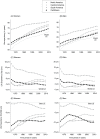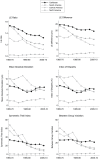Trends in Longevity in the Americas: Disparities in Life Expectancy in Women and Men, 1965-2010
- PMID: 26091090
- PMCID: PMC4474559
- DOI: 10.1371/journal.pone.0129778
Trends in Longevity in the Americas: Disparities in Life Expectancy in Women and Men, 1965-2010
Abstract
Objective: We describe trends in life expectancy at birth (LE) and between-country LE disparities since 1965, in Latin America and the Caribbean.
Methods & findings: LE trends since 1965 are described for three geographical sub-regions: the Caribbean, Central America, and South America. LE disparities are explored using a suite of absolute and relative disparity metrics, with measurement consensus providing confidence to observed differences. LE has increased throughout Latin America and the Caribbean. Compared to the Caribbean, LE has increased by an additional 6.6 years in Central America and 4.1 years in South America. Since 1965, average reductions in between-country LE disparities were 14% (absolute disparity) and 23% (relative disparity) in the Caribbean, 55% and 51% in Central America, 55% and 52% in South America.
Conclusions: LE in Latin America and the Caribbean is exceeding 'minimum standard' international targets, and is improving relative to the world region with the highest human longevity. The Caribbean, which had the highest LE and the lowest between-country LE disparities in Latin America and the Caribbean in 1965-70, had the lowest LE and the highest LE disparities by 2005-10. Caribbean Governments have championed a collaborative solution to the growing burden of non-communicable disease, with 15 territories signing on to the Declaration of Port of Spain, signalling regional commitment to a coordinated public-health response. The persistent LE inequity between Caribbean countries suggests that public health interventions should be tailored to individual countries to be most effective. Between- and within-country disparity monitoring for a range of health metrics should be a priority, first to guide country-level policy initiatives, then to contribute to the assessment of policy success.
Conflict of interest statement
Figures


References
-
- U.S. Department of Health and Human Services: Office of Disease Prevention and Health Promotion—Healthy People 2010. NASNewsletter. 2000;15(3):3 Epub 2002/05/04. . - PubMed
-
- Lawson AB, Kleinman K. Spatial and Syndromic Surveillance for Public Health. Chichester: John Wiley & Sons, Ltd; 2005.
-
- White AD, Folsom AR, Chambless LE, Sharret AR, Yang K, Conwill D, et al. Community surveillance of coronary heart disease in the Atherosclerosis Risk in Communities (ARIC) Study: methods and initial two years' experience. Journal of clinical epidemiology. 1996;49(2):223–33. Epub 1996/02/01. . - PubMed
-
- Jensen OM, Parkin DM, MacLennan R, Muir CS, Skeet RG. Cancer registration: Principles and Methods. Lyon: International Agency for Research on Cancer; 1991.
-
- United Nations Statistics Division. Household Sample Surveys in Developing and Transition Countries (ST/ESA/STAT/SER.F/96/WWW), 2005.
Publication types
MeSH terms
Grants and funding
LinkOut - more resources
Full Text Sources
Other Literature Sources

